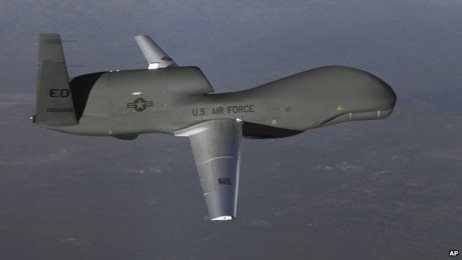At this week`s summit in Newport in Wales, Nato heads of state will agree on a Readiness Action Plan to respond to such crises.
It will involve setting up a new spearhead force of 4-5,000 troops, ready to deploy within 48 hours.
The alliance is also committed to boosting its intelligence gathering and sharing with the use of spy planes and unmanned drones.
Swarm of drones
Earlier this year, a US Military Global Hawk entered British airspace en route to Norway.
It was the first time the highly secretive unmanned surveillance plane had flown over Britain.
Few, if any, would have caught a glimpse of it at 15,240m (50,000 ft), well above the cruising altitude of passenger planes. Nor did many know what it was up to.
The Global Hawk, whose powerful sensors can monitor every single traffic movement in the state of Florida while flying 100 miles (60 km) off the coast, was joining a swarm of other drones, as well as manned spy planes of all shapes and sizes, in the largest ever test of Nato`s ability to gather and share intelligence.
On the ground Nato troops were launching hand-held mini-drones, like the Raven, to give them live pictures of the land ahead.
The trial, called Unified Vision, involved the use of four military satellites, 24 surveillance aircraft, 15 ground-based vehicles with sensors and radars, as well as two warships.
US Global Hawks have already been used over Iraq to locate Islamic State fighters and their positions.
They have also been flown over Nigeria to try to locate hundreds of Nigerian schoolgirls abducted by Boko Haram.
By the end of the decade, Nato too will have acquired five of the high-altitude unmanned spy planes at a cost of $1.7bn (£1bn).
They will be operated out of Sigonella airbase in Sicily and will help the alliance build up what it describes as its "situational awareness" in times of crises.
It is just what Nato needs to develop a clear picture of the build-up of Russian forces on the border with Ukraine.
Revolution in warfare?
That is the kit, but the location for Unified Vision is close to nirvana for the international military alliance too.
Situated in a remote Norwegian fjord with large stretches of uninhabited land, wide empty stretches of water and uncluttered airspace, it is the perfect place to put the technology through its paces.
Its relative isolation also allows military planners to block GPS signals or launch cyber attacks to simulate the challenges of electronic warfare.
Unlike most military exercises, the majority of the 2,000 military personnel involved in Unified Vision were staring at computer screens and live video feeds rather than through the sight of a rifle.
"Computers and computer technology are becoming part of the fabric of warfare," says Dr Richard Wittstruck, who leads Nato`s Joint Intelligence Surveillance and Reconnaissance group.
"As we look at a digital age, the soldier treats the computer as part of his weapon cache. It`s as important as a tank or a rifle or any other weapon," he adds.
Ludwig Decamps, the alliance`s director of aerospace capabilities describes all this reliance on technology as "an evolution in warfare".
It looks and feels more like a revolution.
More than bombs
The challenge for Nato, and the purpose of Unified Vision, is to make sure allies can use all the technology at their disposal and then share the intelligence gathered.
It is no easy task. First the nations that make up Nato use different systems, from aircraft to software. Second, not everyone wants to share all the intelligence they collect.
In Afghanistan it took Nato the best part of a decade to put systems in place that would allow all those countries involved to share intelligence.
Lieutenant Colonel Matt Martin, the joint commander for Unified Vision, says it is vital to prepare for future operations.
"When a Nato campaign kicks off, you don`t know who will show up and what they will bring," he says.
This training is vital for ensuring there is a common set of procedures and systems in place under which they can all work and function together when the next crises arises.
To do that, they rehearse a number of "vignettes", ranging from a humanitarian crisis and fleeing refugees to dealing with an insurgency, and even a full conflict.
In one scenario, a French military analyst interprets the data coming in from a Czech listening station that has been trying to identify the location of a surface-to-air missile battery.
The French analyst then passes on the intelligence to an Italian air commander who orders Norwegian F-16 to destroy the target.
All this information is relayed to a nerve centre, or "intelligence fusion cell", where civilian and military intelligence personnel sift through the data and watch the live feeds from drones flying above.
It has the potential to be a Tower of Babel; English is not the only language being spoken.
Different software and systems have the potential to add to the confusion.
Then there is the task of storing all this information on servers which can be accessed by the different nations taking part.
This trial in Norway tried to iron out some of those challenges. It is also a reminder that the future of warfare is much more than just bombs and bullets.
More about:
















































